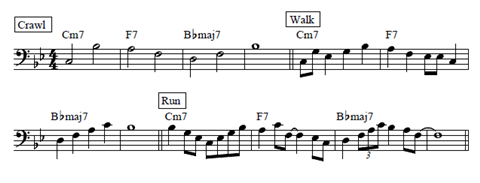Bass player Danny Ziemann illustrates how to build an improvised solo line from a simple bass accompaniment

This excerpt is taken from Technique: Jazz soloing on the double bass in our July 2021 issue
Crawl, walk, run
Many great solos are just a natural extension of what we do when we play walking bass.

Read: Masterclass: Jazz bowings on the violin
Read: How to create an improvised jazz solo on the violin
In exercise 3, use the same harmonic parameters to progress from a two-beat ‘crawl’ to a walking bass and finally a solo ‘run’:
- ‘Crawl’: play the root, 3rd and 7th (guide tones)
- ‘Walk’: play crotchet (q) guide tones, with some quavers (e) if you like
- ‘Run’: now improvise a solo around the guide tones, using new harmonies and rhythms
Bassists are so used to playing rhythmically uniform accompaniments that we often suffer from what I call ‘bass-line paralysis’. We can use varied rhythms such as triplets (exercise 4) to avoid this.












































No comments yet